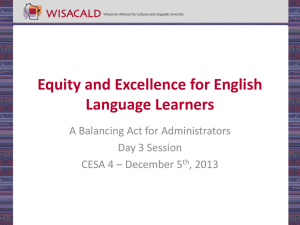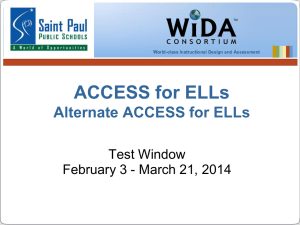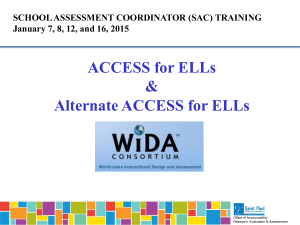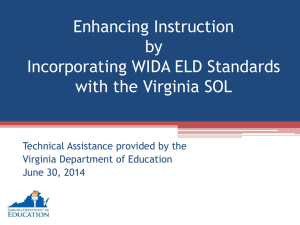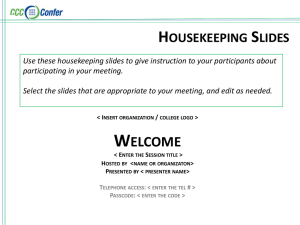Test Administration ACCESS for ELLs
advertisement
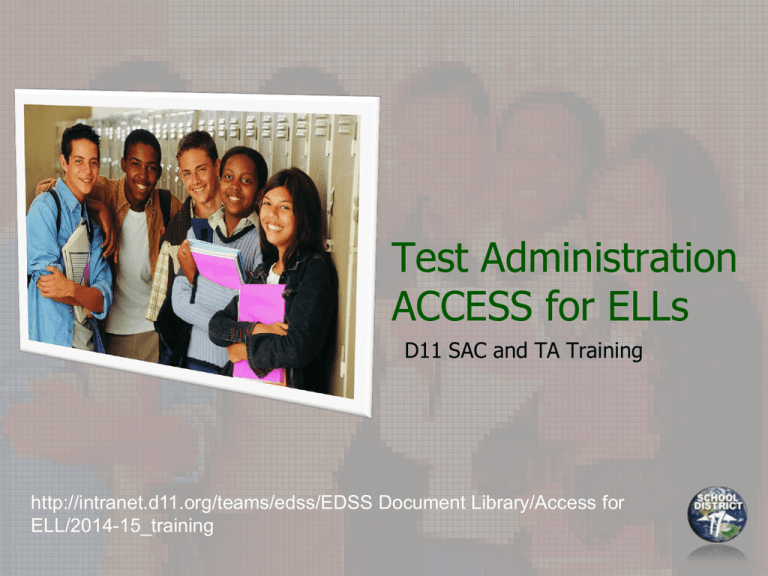
Test Administration ACCESS for ELLs D11 SAC and TA Training http://intranet.d11.org/teams/edss/EDSS Document Library/Access for ELL/2014-15_training Objectives SACs will gain an understanding of – Test Overview – Test Material Handling and Security – Online Training Modules – Scheduling and Coordination – Recommended Test Accommodations for ELLs with Disabilities – Test Administration for Group Testing and Speaking Test Administration – ALL NEW SACs must complete the online training videos. 2 Objectives Test Administrators will gain an understanding of – Test Overview – Test Material Handling and Security – Online Training Modules – Scheduling and Coordination – Recommended Test Accommodations for ELLs with Disabilities – Test Administration for Group Testing and Speaking Test Administration 3 Test Overview Roles and Responsibilities of an ACCESS for ELLs Test Administrator • Attend district’s in-person training(s) for ACCESS for ELLs test administration • Independently complete the appropriate ACCESS for ELLs quizzes on the WIDA Website (www.wida.us) • Handle assessment preparation, materials and administration in a professional and ethical manner • Maintain security of materials and student responses Test Overview ACCESS Testing Window • All Colorado ACCESS for ELLs tests must be administered during the state’s testing window. • January 12 – February 13 • All materials are returned to MetriTech on or before February 19th. 5 Test Overview What is ACCESS for ELLs – ACCESS for ELLs stands for Assessing Comprehension and Communication in English Stateto-State for English Language Learners – The ACCESS for ELLs test assesses students’ English language proficiency in five areas: • Social and Instructional Language (SIL) • English Language Arts (LoLA) • Mathematics (LoMA) • Science (LoSC) • Social Studies (LoSS). – The test forms are divided into five grade-level clusters: Kindergarten, 1–2, 3–5, 6–8, and 9–12. 6 Test Overview What is ACCESS for ELLs – For each grade-level cluster, there is a test in each of the four language domains • Listening • Reading • Writing, • and Speaking – The Listening test and the Reading test consist of multiple-choice questions. – The Writing test and the Speaking test are made up of performance tasks scored according to specific rubrics. – The Listening, Reading, and Writing tests can be group administered and are centrally scored. – The Speaking test is an individually administered, adaptive test that is scored by the test administrator. 7 Test Material Handling and Security SAC Responsibilities Ensure that contents are secure and are treated as secure test materials. Place all secure materials in locked storage. Do not leave materials unattended before or after testing. Do not duplicate any test materials (with the exception of this manual). Do not share specific test information with students prior to or after testing. Be aware that any breaches of test security or problems with test administration may result in the invalidation of student scores. 8 Test Material Handling and Security SAC Responsibilities Read the manual. Follow all directions carefully to ensure accurate reporting of data. Inventory test materials immediately upon receipt. Consolidate and request any additional materials needed for testing. Assign appropriate staff to coordinate test administration. 9 Test Material Handling and Security SAC Responsibilities Ensure that all personnel assigned to testing are adequately trained in test administration and security procedures. Coordinate the distribution of test materials. Coordinate test administration. Emphasize to test administrators that students must use number 2 pencils. Provide District Code number and School Code number to test administrators. Be available to answer questions. Ensure that test materials are returned immediately after test administration. 10 Test Material Handling SAC responsibilities remind test administrators of the importance of verifying the accuracy of: Student Pre-ID labels (if provided) before placing them on the test booklets Signing out and signing in each secure booklet on the Security Checklist (white) Information on the School Header Sheet (blue)— MetriTech will report students based on the school header the test is returned under. 11 Test Material Handling Security Ensure that contents are secure and are treated as secure test materials. Place all secure materials in locked storage. Do not leave materials unattended before or after testing. Do not duplicate any test materials (with the exception of this manual). Do not share specific test information with students prior to or after testing. Be aware that any breaches of test security or problems with test administration may result in the invalidation of student scores. 12 Test Material Handling Security Sign the confidentiality agreement now. Maintain test security prior to and during testing. All of the test materials must be kept secure and confidential. The personnel involved with testing are responsible for ensuring that no test materials are duplicated and that no specific test information is shared with students prior to or after testing. WIDA recommends that test administrators have an opportunity prior to testing students to familiarize themselves with one set of test materials for the grade-level cluster(s) of the test that they will be administering. 13 All student tests should have a Pre-ID label applied to the test booklet or the demographic information filled in on the front and back of the test booklet. Test Material Handling You will receive Tests, Scripts, Speaking Flip Charts, CDs, Kindergarten Manuals (if needed) and Kindergarten Kits (if needed) Pre-ID labels School Bag of paperwork 14 Test Material Handling Pre-ID Labels Test Administrators must verify Pre-ID information prior to applying the labels to the test booklet. If the labels are correct, place the label in the box on the front cover of the test booklet in the designated area. If the labels are incorrect, discard the labels. If the label has been placed on the book in error, mark through the bar code. 15 Test Material Handling Pre-ID Labels 16 Test Material Handling Demographic information The front and back of the test booklet must be completed with a number 2 pencil. It is critically important that student demographic data fields are entered and reviewed carefully. Follow instructions in the TA Manual 17 Test Material Handling Read the letter… Read over the letter that explains the materials procedures SACs And Call 520-2080 if you have any questions Remember all new SACs must complete the online training. 18 Test Material Handling Read the letter… Completely fill out the security checklist Only check out materials to teachers that have been approved SACs If a staff member thinks they should be on the approved list, but they are not, have them call 5202080 Check Q for your current list of EL students If you can’t get into Q desktop, we can print a list for you. 19 Test Administration Training TA Training Test administration training and certification is crucial for successful administration of ACCESS for ELLs. Online and face-to-face training is required in Colorado every year. To receive the online certification from WIDA, test administrators must create a personal training account and take the WIDA training course. 20 Test Administration Training TA Training The Assessment Department will schedule a face-toface training in coordination with the Multilingual Facilitator every year. You must complete the online training and pass each relevant course with an 80% or better BEFORE you can TA the ACCESS for ELLs test. 21 Getting to the Online training TA Training Generic username: colorado password: bluespruce Update new district, school, name change etc. 22 TA Training Forgotten Password? • www.wida.us 23 24 Test Quizzes Test Administration The online training takes approximately two to four hours, depending on which areas you must complete. The online training may be completed in one sitting, or in as many sessions as necessary, ideally within one to two weeks of when you will be administering the test. You can train separately on one, two, or three different areas of ACCESS for ELLs test administration. These areas are: The group-administered test: Listening, Reading, and Writing. The Speaking test. The Kindergarten test. 25 Test Administration Test Accommodations Available to students that have a disability documented through an IEP or 504. (pg. 43 in Manual) Reference the Colorado ACCESS for ELLs Accommodations chart Use the WIDA Guidelines for Accommodating ACCESS for ELLs Language Learners with Disabilities document Visit the website (also in the packet) http://www.cde.state.co.us/sites/default/files/ACCES S%20for%20ELLs%20Accommodations%20October1 4_0.pdf 26 Scheduling and Coordination Test Scheduling Your SAC will work with you to plan the master schedule. • Speaking: Administered Individually, untimed plan on 15-20 minutes per student • Listening: Group Administered, timed (length of the CD 25-45 minutes) • Reading: Group Administered, timed 45 minutes • Writing: Group Administered, timed 65 minutes 27 Scheduling and Coordination Test Scheduling Please note that for the group administered sessions you should allot about 15 minutes in addition to the times listed below to convene students and distribute/collect test materials. See the TA manual for exact times The sections of the test may be administered in any order. A single section should NOT be broken into several administrations 28 Scheduling and Coordination Test Scheduling No more than 22 students in a group section See the TA manual for exact times The sections of the test may be administered in any order. A single section should NOT be broken into several administrations 29 Schedule only one Tier Schedule only one grade-level cluster younger students and students with very limited English proficiency may be tested in smaller groups. If possible, test the same students together Scheduling and Coordination Individual Administration Test Sessions Plan for at least 15 minutes for Speaking test administration for Grades 1-12 Plan for up to an hour for Kindergarten administrations For each test administrator, allow several minutes between students so that they can reset the materials, return the student to his or her classroom as necessary, and pick up the next student. You should have separate rosters for Speaking test administrations (Grades 1-12) and Kindergarten Speaking test administrations. 30 Scheduling and Coordination The testing room Arrange the desks in rows, facing forward, where you, the test administrator, can see all students and circulate between desks. It is important that all students can see and hear you clearly. Obtain enough sharpened pencils for students being tested. Make or obtain from your SAC a Do Not Disturb: Testing sign to be placed on the outside of the testing room door during test sessions. 31 Scheduling and Coordination The testing room Plan to have a table on which to lay out test materials. Have on hand reading materials for students who finish early. Have a watch on hand, or make sure there is a functioning clock in the testing room. The Test Administrator’s Script contains guidance on pacing the test. Note that it is not necessary to cover any print on the walls or on classroom materials. 32 The Group test Test Administration Test forms are available in three overlapping tiers for each grade level cluster Tier A: proficiency levels 1-3 Tier B: proficiency levels 2-4 Tier C: proficiency levels 3-5 Test administrator scripts are different for each test form (scripts are secure) Centrally scored by MetriTech, Inc. not by the Test Administrator 33 The Group test Test Administration Test booklet sequence: Listening Reading Writing Each test will begin with practice or sample items Organized by theme folders: A series of questions about one topic with graphic and/or text support Each theme folder for Listening and Reading contains 3-4 items (test questions) Writing test includes 3 tasks, except Grades 1-2 Tier A has 4 tasks 34 The Group test Test Administration Listening Administration: 20-40 minutes (varies by grade & tier) Reading Administration: 45 minutes Writing: Depending on Tier 30 minutes 45 minutes 60 minutes Extended time is available for students that have an IEP or 504; extended time is time and a half. 35 The listening test Test Administration The ACCESS for ELLs Listening Test is media-delivered. Listening Test items are delivered via CD or streamed from the MetriTech website (https://www.metritech.com/WIDA/Listening/login.aspx). Rationale: Increase standardization of administration Ease the workload of test administrators Thoroughly read through the manual beginning at page 51 for detailed instructions Contact MetriTech Customer Service at (800)747-4868 or WIDA@metritech.com for a user name and password for access to the streaming audio files https://www.metritech.com/WIDA/Listening/login.aspx Follow the script exactly. No improvising. 36 The listening test Test Administration Test items are only played once unless there is an emergency event or extremely unusual circumstance. Pausing between tracks is not necessary, as a 25 second (plus 5) response time is included in the track for each test item Answer choices may not be read out loud. And 37 The listening test Test Administration Two practice items are included to familiarize students with the structure of the test. Practice items will require reading aloud and playing/pausing the audio files at certain points as indicated in the Test Administration Script. Practice items are not scored. Playing and pausing is only for practice items. 38 The listening test Test Administration 39 The Reading Test Test Administration follow the Test Administrator’s Script exactly The Reading Test is designed to take no more than 35 to 45 minutes Format: Multiple choice, group administered 6-7 thematic folders: each folder is centered on one standard (Language of: Math, Science, Language Arts, Social Studies, Social Instructional) Item prompts and answer choices may NOT be read aloud Keep the test going at a steady pace Circulate through the testing room and monitor student work 40 Individual and Group Checkins Test Administration Intended to help guide students through parts of the test Indicated with a stop sign Whole-group check-ins Check in with all of the students at the same time and explain the next part of the test. Occurs after every section in the 1-2A Reading Test. Individual check-ins Students raise their hand when they arrive at a stop sign and you check to see if students have completed the section. Occurs halfway through 1-2B, 1-2C, 3-5A, 3-5B, 68A, 9-12A and at the end of every reading test 41 Sample practice items Test Administration Practice items follow the introduction and must be administered. Only on forms for Grade Level Cluster 1-2, Tiers A and B 1-2A samples occur at the beginning of every folder and are scripted (the answer is filled in together as a group) 1-2B samples occur at the beginning of some folders and are not scripted Marked with a letter ‘S’ 42 Sample practice items Test Administration 43 The Writing Test Test Administration Format: Student constructed response, group administered Encourages ELLs to demonstrate their general communicative ability in writing in English. Time: Up to 65 minutes if needed 3 Parts (except Grades 1-2 Tier A has 4 Parts) The following standards are covered: Grades 1-2 Tier A: SIL Grades 3-12 Tier A: SIL, LoLA, LoMA/LoSC Grades 1-12 Tiers B & C: SIL, LoMA/LoSC, IT (LoLA/LoSS/SIL) 44 The Writing Test Test Administration Although each part is not individually timed, timing guidelines are provided, and students should be monitored and encouraged to keep pace. TAs may end the test when all students are finished. Follow the Test Administrator’s Script exactly. Read over the Writing section of the manual completely. 45 The Writing Test Test Administration Whole-group and individual check-ins are indicated by stop-sign symbols in the test booklets. For tasks that contain a sample, the time it takes to explain the sample writing is included in the overall time allocated for the Writing Test. Monitor students periodically, encouraging them to keep pace. Responses are scored for the student’s general communicative ability in writing in English. Students should address each task completely; however, the number of sentences or paragraphs written is not a scoring criterion. 46 The Writing Test Test Administration Keep the test going at a steady pace Circulate through the testing room and monitor student work to keep pace Follow the Test Administration Script exactly Task items (unless scripted) may NOT be read aloud Students should be encouraged to keep pace so they can do their best on the longest task at the end. If necessary, you can prompt students who are lagging behind by saying, “Make sure you save enough time for the other parts.” 47 Test Administration The Speaking Test Speaking test contains A warm-up to help put the student at ease The test questions A wind-down intended to leave the student with a positive impression of his or her performance on the test Test questions are grouped into thematic folders (identified as “Parts” within the test). The targeted proficiency level of each task increases throughout each Part. administered individually to students in an interview format 48 Test Administration The Speaking Test Test in a quiet room free of distractions Test administration is standardized, and all test parts are scripted. Maintain the flow of the test. Flip the pages of the test booklet yourself unless otherwise indicated. 49 Test Administration The Speaking Test You may give the student non-judgmental, positive reinforcement repeating a question one time is acceptable. evaluate and score student responses immediately after the student gives a response. Become familiar with task-level expectations, the rubric, and scoring criteria 50 Logistics of Administering the Speaking Test The speaking test includes three thematic folders, identified as “Parts” within the test. Part A: tasks 1-3 cover SIL at proficiency levels 1-3 Part B: tasks 1-5 cover LoLA and LoSS at proficiency levels 1-5 Part C: tasks 1-5 cover LoMA and LoSC at proficiency levels 1-5 Each task is aimed at eliciting speech at one particular English Language Proficiency (ELP) level within the WIDA Speaking Rubric Task 1 aims for speech at ELP Level 1 Task 2 aims for speech at ELP Level 2, and so on 51 Logistics of Administering the Speaking Test Remember ALL students start in Part A Tier A students start on Part A Task 1 (T1) Tier B and Tier C students start on Part A Task 2 (T2) Tier A Start Tier B and C Start 52 Test Administration The Speaking Test Three parts Part A: Social and Instructional Language Part B: Language of Language Arts and Language of Social Studies Part C: Language of Mathematics and Language of Science Exceeds is used when a response scores beyond the expectations of the task Meets is always the intended target for a speaking task Approaches is used when the response does 53 not meet one or more expectations of the task Test Administration The Speaking Test If in doubt between scoring Meets or Approaches on a task, you can check the question mark “?” column on the score sheet and administer the next task. If the student Meets the next task level expectations, assign that task a score of Meets, and go back and assign the previous task in question a score of Meets. If the student fails to meet the task level expectations on the next task, it is most likely that the performance was also deficient on the previous task. Assign the current task a score of Approaches or No Response as appropriate, and go back and assign the previous task in question a score of Approaches. The question mark CANNOT be used on the last task (T3 in Part A or T5 in Parts B and C) 54 Additional Training Resources 55 Resources providing detailed administration guidelines and information: Online ACCESS Test Administrator Training Course – Speaking Module (from the WIDA website) View the T2 Start procedure Tutorial District and School TAM (downloadable from the WIDA website) PowerPoint: Administering the Speaking Test T-2 Start Procedure in the ACCESS Tool Kit Supporting files in the Speaking Test Administration folder in this Tool Kit Additional Training Resources 56 Resources providing detailed administration guidelines and information: Online ACCESS Test Administrator Training Course – Speaking Module (from the WIDA website) View the T2 Start procedure Tutorial District and School TAM (downloadable from the WIDA website) PowerPoint: Administering the Speaking Test T-2 Start Procedure in the ACCESS Tool Kit Supporting files in the Speaking Test Administration folder in this Tool Kit


